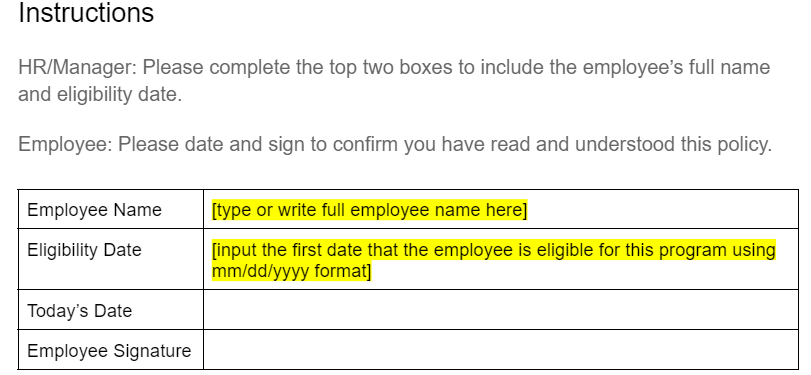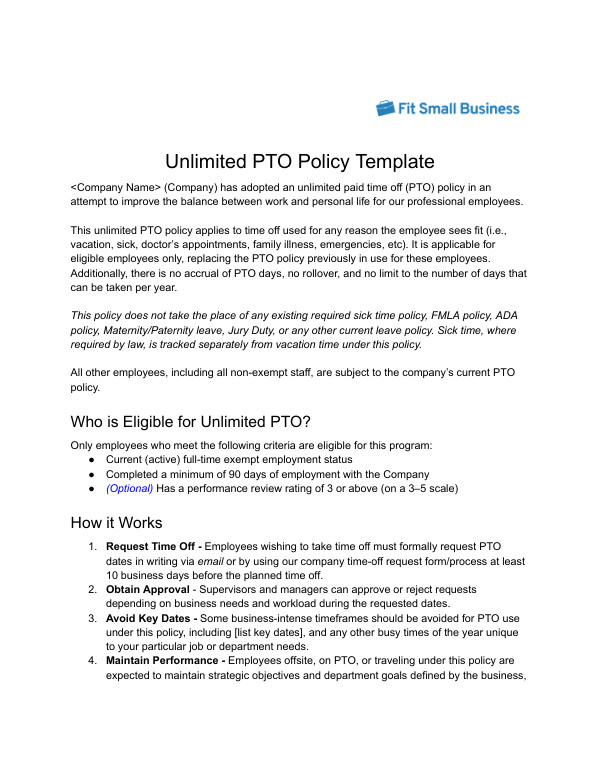An unlimited paid time off (PTO) policy allows employees to take as much time off as they need or want in a given year, without a limit. There is still generally a structured PTO request/approval process but just no hard cap on the number of days allowed.
Knowing how to create an unlimited paid time off policy helps employers communicate to employees the expectations around PTO. Companies experiment with this option to improve work culture, give exempt employees a better work-life balance, and allow senior staff more vacation and personal time.
There are pros and cons to offering unlimited PTO, but creating a solid policy outlining clear expectations can help make it successful. Download our unlimited PTO policy template below.
Step 1: Identify Who Is Eligible
Businesses providing unlimited PTO can make it available to only certain types of employees—exempt salaried employees being the most common. There are, however, groups that unlimited PTO will work well for and those it may not be right for.
| PROS | CONS |
|---|---|
| Exempt salaried employees: An unlimited PTO policy allows these employees to take off work as needed. Learn more about exempt vs non-exempt employees. | Non-exempt staff: They must be paid for all hours worked, even while on vacation. If an employee prefers to spend their time while on PTO working, you’d have to pay for that time. |
| Consultants and information technology (IT) or project-based employees: These salaried employees are typically available 24/7. An unlimited PTO policy allows them to take time off on an as-needed basis. | Staff with no backup:If you have only one person in a role who goes on an extended leave, you may not have anyone to manage the work while they are gone. Unlimited PTO won’t work well in this scenario. |
| Commissioned salespeople: They work odd hours for travel and are typically required to meet financial objectives. It’s a good idea to include these workers in an unlimited PTO policy. | New hires: You may wish to offer them traditional PTO for a certain period (i.e., 90-360 days) before making them eligible for an unlimited PTO policy. |
Step 2: Explain How It Works
In your policy, tell your employees how the policy works and the procedure for requesting time off. We recommend listing the following:
- Request time off: Explain to your employees the procedure for requesting time off. For example, “Employees wishing to take time off must formally request PTO dates in writing via email or by using our company time-off request process at least 10 business days in advance of the planned time off.”
- Obtain approval: Notify employees about the avenues they must take to gain approval for their PTO. For example, “Supervisors and managers can approve or reject requests depending on business needs and workload during the requested dates.”
- Avoid key dates: If there are times throughout the year, such as busy seasons or holidays, that will not be approved for time off, make that clear in your policy. For example, “Some business-intense timeframes should be avoided for vacation and offsite travel under this policy, including tax time, fiscal planning/budgeting, and other busy times of the year unique to your particular job or department needs.”
- Maintain performance: Let employees know that their performance metrics must still be met regardless of the amount of time they choose to take off. For example, “Employees offsite, on vacation, or traveling under this policy are expected to maintain strategic objectives and department goals as defined by the business, management, or supervisor. Failure to maintain business performance/work results will be managed as a disciplinary issue.”
Step 3: Set Guidelines
Your unlimited PTO policy should not be an open-ended policy with no guidelines. It should include parameters around using it, including what happens to unused PTO when employees leave the company.
- No limits but clear expectations: Be clear that although your PTO policy is unlimited, performance and productivity expectations must still be met. For example, “There are no limits on how much time an employee can take under this policy each year. However, employee performance will be managed to ensure that agreed-upon deliverables and work efforts are maintained in accordance with the employee’s job description and annual planning activities.”
- No accruals/rollover: Since your policy is unlimited, there would not be an accrual method for gaining PTO. Additionally, as there is no limit, no PTO amounts may be rolled over to the next year. Make this clear in your policy. For example, “Unlike traditional sick time and PTO policies, time does not accrue under this policy. In other words, there is no PTO or vacation time bank under this policy. As such, there is no rollover of any kind from year to year.”
- No payout: An unlimited PTO policy does not put a cap on the number of days you can take off. Because of this, there will be nothing to calculate when an employee leaves the company. Be sure to notify employees that they will not receive accrued/unused PTO payouts in their final paycheck. For example, “Because time does not accrue under this policy, no payout of unused time is available upon termination. There is no ‘cash out’ option.”
If you are switching to an unlimited paid time off policy from a traditional PTO policy, this may come with unused, accrued, or rollover PTO in an employee’s bank. You may want to make the transition to unlimited PTO during a natural time frame, such as calendar, fiscal, or benefits year-end. Be clear that the old policy will be replaced and any unused vacation at the end of the prior timeframe will be lost.
Step 4: Provide Instructions
In this section of your unlimited time off policy, explain that both the employee and their manager (or HR representative) must sign the document. Provide a section for the employee’s name and eligibility date; filled out by a manager or HR rep. Then add a section for the employee’s signature and the date signed.
Below is a sample of this section from our downloadable unlimited PTO policy template.

Be sure to have your employees sign and date your unlimited PTO policy and keep it in their personnel files.
Labor Laws to Consider When Crafting an Unlimited PTO Policy
To avoid confusion with labor laws that mandate paid sick time, unlimited PTO should apply only to vacation or personal time. Several states mandate how much sick time must be provided to employees, and that bank of time should be tracked separately from vacation.
Pay close attention if you’re in a state or locality that requires businesses to provide a minimum amount of sick leave, such as:
- New York, which requires 40 hours per year earned sick time if you have 5 to 99 employees and 56 hours per year earned sick time if you have over 100 employees
- Illinois, which requires a mandatory 40 hours per year for sick leave
- California, which requires five days (or a minimum of 40 hours) per year for sick leave (note: the five-day rule may mean more sick hours if the employee works more than 40 hours in a five-day period)
Other policies, like those dealing with the Family and Medical Leave Act (FMLA), the Americans with Disabilities Act (ADA), and Maternity/Paternity Leave, require specific amounts of time for leave. Refer to our guide on Federal Labor Laws Every Small Business Should Know to learn more.
How to Track Unlimited Paid Time Off
Without a clear system for tracking employee time, unlimited PTO can quickly turn into a nightmare for managers. It may become difficult to ensure that employees are taking the time they need to recharge and reset and that they’re not taking advantage of the system.
Additionally, there is still a level of employee management responsibility that comes with any PTO policy, along with the benefit of knowing how much time your employees are taking off to gauge their productivity. Once you have the guidelines in place, you can choose from a variety of tracking methods.
- Ask employees to keep their own records (like a calendar system) and submit them periodically
- Use time and attendance tracking software
- Use employee scheduling platforms
Gusto, the top pick in our payroll software for small businesses guide, can track both vacation and sick time. It also allows you to customize your PTO to fit your business needs, and your employees can request time off online or through a mobile app. It then automatically syncs with your payroll for seamless processing.
Pros & Cons of Unlimited PTO
Having a clear unlimited PTO policy in place can help highlight the pros and limit the cons associated with this type of program.
| PROS | CONS |
|---|---|
| Employee job satisfaction and performance may increase as they feel they have adequate work-life balance. | Employees could take advantage of the policy by taking time off every week or taking a long paid leave of absence. |
| Employees may be more readily available at the end of the year, as they will not be trying to use their PTO before they lose it. | May be limited to certain employees in the company, which can lead to dissatisfaction for those unable to participate. |
| It helps with hiring and retention when a company offers a robust PTO policy. | Employees may not use many PTO days to avoid being accused of abusing the policy, leading to the feeling of stress and being overworked. |
| It may save the company money. Since there is no time accrued, there is nothing to pay out when employees leave their posts. | Your company could be left without enough employees to handle daily activities if a good policy is not put into place. |
Tips for Creating a Clear Policy
Creating and distributing a strong policy outlining your PTO structure is key when introducing an unlimited paid time off option to your employees. Include the timeline for when the policy will roll out, who’s eligible, and what happens to the old policy once the new one is in place.
You should also establish parameters to ensure important work gets completed, deadlines are met, and the policy isn’t abused. Put this policy in writing (making it part of your employee handbook, for example).
Consider these simple tips when crafting and implementing your unlimited PTO policy.
- Require employees to request leave and get it approved by their supervisor 5 to 30 days before their time off to ensure proper coverage during their absence.
- Make it clear if employees cannot request time off during key business events that require them to be onsite—such as key project dates, system implementation dates, and budget or strategic planning periods.
- Provide a limit to the number of staff in one department that can be on PTO simultaneously.
- Require that individual or team performance and productivity are not impacted by employee absences based on your department’s performance standards, metrics, or KPIs.
- Ensure it’s clear that flexible leave cannot be accrued, rolled over, or cashed out.
Unlimited Paid Time Off (PTO) Policy Frequently Asked Questions (FAQs)
An unlimited PTO policy is just like a regular PTO policy. It outlines the expectations surrounding taking paid time off and how to request time. The only difference is that a regular paid time off policy limits the amount of time you are allowed to take off within a given year. An unlimited PTO policy allows employees to take as much time off as they need, with no cap.
Unlimited PTO is beneficial to both employees and employers. For the employee, it allows them to take the time they need to handle personal situations or care for themselves or loved ones, without the fear of running out of available days. For employers, it shows that you are flexible and care about the welfare and work/life balance of your employees.
Since unlimited PTO has no limit on the number of days an employee can take paid time off, there is a possibility that employees could abuse the policy. Additionally, it could create a situation where employees are unsure if they are even allowed to use paid time off.
To circumvent these issues, make your unlimited paid time off policy clear by setting a minimum amount of time employees are expected to use and stipulations on when PTO will be approved or not approved.
Bottom Line
For small businesses, unlimited PTO can improve morale and make your workplace more desirable, allowing you to attract top talent. However, be sure when creating your unlimited paid time off (PTO) policy that you’re aware of state/federal leave laws and even local mandatory sick leave requirements that may impact the exact wording of your PTO policy.


